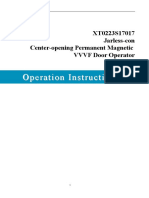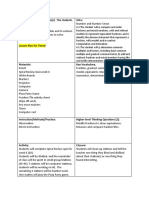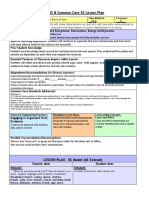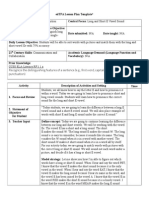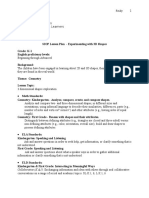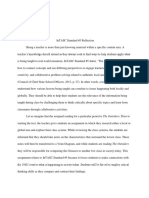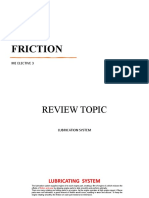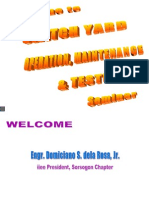5e Lesson Twirly Birds
5e Lesson Twirly Birds
Uploaded by
api-400494124Copyright:
Available Formats
5e Lesson Twirly Birds
5e Lesson Twirly Birds
Uploaded by
api-400494124Original Title
Copyright
Available Formats
Share this document
Did you find this document useful?
Is this content inappropriate?
Copyright:
Available Formats
5e Lesson Twirly Birds
5e Lesson Twirly Birds
Uploaded by
api-400494124Copyright:
Available Formats
Elementary Science 5E Lesson Plan
Lesson: Twirly Birds Grade Level: 3rd Date: October 19th
NGSS and Common NGSS: 3-PS2-1- Plan and conduct an investigation to provide evidence
Core Standards of the effects of balanced and unbalanced forces on the motion of an
object.
3-PS2-2- Make observations and/or measurements of an object’s
motion to provide evidence that a pattern can be used to predict
future motion.
CCSS: CCSS.ELA-LITERACY.RI.3.1- Ask and answer questions to
demonstrate understanding of a text, referring explicitly to the text as
the basis for the answers.
CCSS.ELA-Literacy.W.3.7- Recall information from experiences or
gather information from print and digital sources; take brief notes on
sources and sort evidence into provided categories.
Key Concepts Variables in patterns of motion
Applying force to predict motion
Objective for Students will be able to predict how a force will change an object’s
Students motion and what variables affect the object’s motion.
Engage: What is the Objectives for students up on board
focus of the lesson? Watch this video to get students to begin thinking about the flight of a
helicopter and how it works.
https://www.youtube.com/watch?v=-TZxle7GNaI
Ask students what would happen if there were different sized
helicopters. What might need to change?
Students will become toy makers with this engaging scenario: “The
Lewiston Toy Company is very pleased with the information we have given
them about balancing and spinning toys. They now have a new problem.
They are thinking about making some spinning toys that fly. The Lewiston
Toy Company thinks these models could be used to make more toys and they
need your help in testing them to see if they will work. They have sent us
some materials and printed information that may help us. They also need us
to continue to keep accurate records and labeled drawings in our science
notebooks so we can report what we found out in a couple of weeks.”
Explore: What will Students will be constructing a twirly bird and discovering which
the students do? factors affects its flight with a partner. Students will think it, design it,
build it, test it, and refine it. (fill in investigation 2.3 packet) below
Students will then pick their best design to test in a target area where
they will receive points for accuracy.
Explain: What is the Discuss which different variables affected the flight of the twirly bird.
main concept? Why does the twirly bird go to the floor? What makes it do that? Why
doesn’t it float up? What makes the twirly birds go at different speeds?
What is the opposite force acting on the bird? How does it move
down and not side-to-side? Which design allowed for the best flight?
Worst flight? Which variables did you change? How could toy makers
test variables to make the best flying helicopter?
***Answer all these questions allowing extended wait time and
questioning their responses.
Extend: How will Vocabulary definition word wall
this concept be At home, create other twirly birds with our resources (straws,
expanded and cardstock, larger twirly bird, more weight) bring in twirly bird to show
Foss Online Resources:
connected to real
“brainpop” activities
life?
Videos: all about motion and balance
Evaluate: How will Formative: Check science sheets/ notebooks throughout the lesson.
the students show Listen to students reactions to the “testing” of the twirly birds.
what they have
Summative: Have students write a letter to the Lewiston Toy Company
learned?
explaining why their design should be picked as the model and why it
works the best.
Materials and Elmo/Projector & YouTube video
Technology Lewiston Toy Company Scenario
Needed Twirly birds model
Twiry bird directions
Paper clips
Scissors
Student Recording Sheets (Rebecca Seeley)
Student Vocabulary Cards (Rebecca Seeley)
Word Wall
Foss Online Resource Access
Vocabulary Gravity, variable, twirly bird, standard
Resources/ Works Foss Website: https://www.fossweb.com
Cited Whirly Bird Template: https://www.sciencebuddies.org/science-fair-
projects/project-ideas/Aero_p015/aerodynamics-
hydrodynamics/make-a-whirly-bird-from-paper#materials
Rebecca Seeley “Science and Motion & Matter Student Journal”
Engage Idea: http://www.lewistonschools.net/wp-
content/uploads/2016/04/Balance_Motion_LE_2.pdf
Target Roto-Target Idea:
https://www.exploratorium.edu/science_explorer/roto-copter.html
Differentiated Vocabulary Cards from Rebecca Seeley
Instruction Working with a partner to build and modify twirly bird
Word Wall reference
Higher Order Can anyone think of any other balanced/unbalanced toys?
Questions How can this be used when engineers are designing helicopters?
If gravity is pulling down, where do you think the Earth’s center of
gravity is?
How could this be different if we were on the moon? Does it have a
different center of gravity?
Reflections (After
the lesson)
You might also like
- Danielson LP 12.6Document5 pagesDanielson LP 12.6Melissa MielkoNo ratings yet
- Jarless Con Door DriveDocument16 pagesJarless Con Door DriveRoyal Akash100% (6)
- Science Lesson PlanDocument6 pagesScience Lesson Planapi-347975424No ratings yet
- Content Area Lesson PlanDocument10 pagesContent Area Lesson Planapi-583719242No ratings yet
- Te 331 Math Lesson CinerDocument16 pagesTe 331 Math Lesson Cinerapi-494433412No ratings yet
- Generalization Lesson Plan 3Document10 pagesGeneralization Lesson Plan 3api-446896467No ratings yet
- Siop Lesson PlanDocument2 pagesSiop Lesson Planapi-445759289No ratings yet
- RainbowfishlessonplanDocument5 pagesRainbowfishlessonplanapi-341402633No ratings yet
- Lesson Plan - Kindergarten Math 2Document4 pagesLesson Plan - Kindergarten Math 2api-430079796No ratings yet
- Week 32 Lesson PlansDocument5 pagesWeek 32 Lesson Plansapi-456187483No ratings yet
- (Complete Answers in Purple Font) : STEM 433/533 Lesson Planning TemplateDocument4 pages(Complete Answers in Purple Font) : STEM 433/533 Lesson Planning Templateapi-510369386No ratings yet
- 3-ps2-2 Predictable MotionDocument8 pages3-ps2-2 Predictable Motionapi-313693680No ratings yet
- Differentiation PlansDocument7 pagesDifferentiation Plansapi-507182013No ratings yet
- Summative Assessment Lesson PlanDocument4 pagesSummative Assessment Lesson Planapi-363015523No ratings yet
- NGSS & Common Core 5E Lesson Plan: Engaging in Argument From EvidenceDocument3 pagesNGSS & Common Core 5E Lesson Plan: Engaging in Argument From Evidenceapi-300263583No ratings yet
- Cep Lesson Plan TemplateDocument12 pagesCep Lesson Plan Templateapi-557959565No ratings yet
- FractionlessonplanDocument6 pagesFractionlessonplanapi-285424348No ratings yet
- Thematic UnitDocument39 pagesThematic Unitapi-31712398750% (2)
- Lesson Plan Ted 508Document4 pagesLesson Plan Ted 508api-486161267100% (1)
- Intasc Standard 1 Learner DevelopmentDocument7 pagesIntasc Standard 1 Learner Developmentapi-253456954No ratings yet
- Tier 2 Lesson Plan - U5w3Document4 pagesTier 2 Lesson Plan - U5w3api-445935606No ratings yet
- Cinderella Stories - 339Document7 pagesCinderella Stories - 339api-456327655No ratings yet
- Philosophy of LiteracyDocument8 pagesPhilosophy of Literacyapi-236468149No ratings yet
- SIOP Instructional Unit Plan Thematic Topic: Inventors Grade/Class/Subject: 5 StandardsDocument6 pagesSIOP Instructional Unit Plan Thematic Topic: Inventors Grade/Class/Subject: 5 Standardsmglanzman15100% (1)
- Week 3 Third Grade Digital Learning Lesson PlansDocument4 pagesWeek 3 Third Grade Digital Learning Lesson Plansapi-312354951No ratings yet
- Rica Reflection Competency 3Document2 pagesRica Reflection Competency 3api-296624078No ratings yet
- 1st Grade Reading Lesson PlanDocument5 pages1st Grade Reading Lesson Planapi-483325082100% (1)
- CBM Presentation HandoutsDocument35 pagesCBM Presentation HandoutsMj De Guzman AngelesNo ratings yet
- Pre-Planning: CC.1.1.1.D: Know and Apply Grade Level Phonics and WordDocument7 pagesPre-Planning: CC.1.1.1.D: Know and Apply Grade Level Phonics and Wordapi-280008473No ratings yet
- Alliant Hsoe Lesson Plantemplate Goal-Based LessonDocument4 pagesAlliant Hsoe Lesson Plantemplate Goal-Based Lessonapi-534596308No ratings yet
- 4th Grade Math LessonDocument3 pages4th Grade Math Lessonapi-239773259No ratings yet
- C Canfield Edtpa Unit PlanDocument16 pagesC Canfield Edtpa Unit Planapi-242212465No ratings yet
- Gems 5-E Lesson Plan 1Document12 pagesGems 5-E Lesson Plan 1Geovannie RetiroNo ratings yet
- Siop Lesson Plan Wida Level 3Document6 pagesSiop Lesson Plan Wida Level 3api-248121250No ratings yet
- Siop - Science Lesson Plan 5th GradeDocument4 pagesSiop - Science Lesson Plan 5th GradeReginald JacksonNo ratings yet
- Reflection For Math Lesson 30-40Document1 pageReflection For Math Lesson 30-40api-336072959100% (1)
- Supervisor Obs 1 Lesson Plan - Place Value Small GroupDocument9 pagesSupervisor Obs 1 Lesson Plan - Place Value Small Groupapi-527837589No ratings yet
- Study of Student Achievement 2Document23 pagesStudy of Student Achievement 2api-543821252No ratings yet
- Lesson Plan For Observation On 2-10-16Document10 pagesLesson Plan For Observation On 2-10-16api-320426519No ratings yet
- Formal Observation Form TeacherDocument3 pagesFormal Observation Form Teacherapi-355294817No ratings yet
- Josue Jimenez EDSP 525 Case Study: Dr. RamirezDocument12 pagesJosue Jimenez EDSP 525 Case Study: Dr. Ramirezapi-481591637No ratings yet
- Vocabulary Lesson Plan - Hungry CaterpillarDocument3 pagesVocabulary Lesson Plan - Hungry Caterpillarapi-311458903No ratings yet
- Educ 540 Domain 1 ReflectionDocument6 pagesEduc 540 Domain 1 Reflectionapi-267230750No ratings yet
- Differentiated AssessmentDocument1 pageDifferentiated AssessmentCherylDickNo ratings yet
- Megan Ebert Final Edtpa Direct Instruction-Eled 3111Document3 pagesMegan Ebert Final Edtpa Direct Instruction-Eled 3111api-301870140No ratings yet
- Mini Lesson Plan 7Document3 pagesMini Lesson Plan 7api-260889954100% (1)
- Map Skills Lesson Plan 1Document7 pagesMap Skills Lesson Plan 1api-240434269100% (1)
- Artifact 1 Inference Lesson Plan With A ReflectionDocument16 pagesArtifact 1 Inference Lesson Plan With A Reflectionapi-418336490No ratings yet
- 1st Grade Voting Lesson PlanDocument4 pages1st Grade Voting Lesson Planapi-339178917No ratings yet
- EE 333 Third Grade Introduction To Multiplication Unit Lesson PlanDocument32 pagesEE 333 Third Grade Introduction To Multiplication Unit Lesson Plancdavila2No ratings yet
- Lesson Plan #2Document6 pagesLesson Plan #2Jason DonaldsonNo ratings yet
- Assessment - SIOP Lesson Plan Final - ReidyDocument7 pagesAssessment - SIOP Lesson Plan Final - ReidyGinaNo ratings yet
- The Pledge of Allegiance Lesson II IdeaDocument4 pagesThe Pledge of Allegiance Lesson II Ideaapi-284927729No ratings yet
- Ot1 Social Studies and Arts Lesson Two AssignmentsDocument6 pagesOt1 Social Studies and Arts Lesson Two Assignmentsapi-405595750No ratings yet
- Unit Plan Math Lesson 3 of 6Document4 pagesUnit Plan Math Lesson 3 of 6api-193663371No ratings yet
- Lesson 22 - ElaDocument11 pagesLesson 22 - Elaapi-357400202No ratings yet
- Infect Me Not Lesson PlanDocument19 pagesInfect Me Not Lesson PlanCristina Barboza PérezNo ratings yet
- Intasc Standard 5 ReflectionDocument2 pagesIntasc Standard 5 Reflectionapi-402221138No ratings yet
- K-3 Lesson Plan Framework: Cake To Answer Comprehension QuestionsDocument5 pagesK-3 Lesson Plan Framework: Cake To Answer Comprehension Questionsapi-278470419No ratings yet
- Lesson Plan Component CriteriaDocument3 pagesLesson Plan Component Criteriaapi-283844389No ratings yet
- A Teacher's Guide to Using the Next Generation Science Standards with Gifted and Advanced LearnersFrom EverandA Teacher's Guide to Using the Next Generation Science Standards with Gifted and Advanced LearnersRating: 4.5 out of 5 stars4.5/5 (9)
- Work, Power and EnergyDocument22 pagesWork, Power and EnergyFrancis FrimpongNo ratings yet
- Activity JD 2Document5 pagesActivity JD 2Janardan Dubey100% (6)
- As 2001.2.3.2-2001 Methods of Test For Textiles Physical Tests - Determination of Maximum Force Using The GraDocument4 pagesAs 2001.2.3.2-2001 Methods of Test For Textiles Physical Tests - Determination of Maximum Force Using The GraSAI Global - APACNo ratings yet
- Transformer Test Report: LA DOC. NO: LA-R-TR-003Document8 pagesTransformer Test Report: LA DOC. NO: LA-R-TR-003mayur dhandeNo ratings yet
- Proposed Scheme For Plugging Three-Phase Induction Motor: January 2010Document6 pagesProposed Scheme For Plugging Three-Phase Induction Motor: January 2010Bilal HBNo ratings yet
- Science 10 11.2 MagnetismDocument23 pagesScience 10 11.2 MagnetismYuriNo ratings yet
- Lab Report 6 Saaim Ahmed - 417524Document9 pagesLab Report 6 Saaim Ahmed - 417524Zain AhmedNo ratings yet
- Section - 1: Meo Class 4 - Electrical Oral Questions With AnswersDocument81 pagesSection - 1: Meo Class 4 - Electrical Oral Questions With Answersbaba maachoNo ratings yet
- Level 4 Homework HamptonDocument6 pagesLevel 4 Homework Hamptonafnawepeaavrlj100% (1)
- 3 Phase Full Wave Bridge ConverterDocument4 pages3 Phase Full Wave Bridge Convertersubhasishpodder100% (1)
- ANNEX 01 - Technical Specifications: 1. 110kV Circuit BreakerDocument4 pagesANNEX 01 - Technical Specifications: 1. 110kV Circuit BreakercuongbkeNo ratings yet
- Structural Dynamics: M.E. in Earthquake EngineeringDocument32 pagesStructural Dynamics: M.E. in Earthquake EngineeringSarose PrajapatiNo ratings yet
- Patent US5436518 - Motive Power Generating Device - Google Patents US5436518 Working Provent Permanent Magnet Motor That Uses No ElectricityDocument29 pagesPatent US5436518 - Motive Power Generating Device - Google Patents US5436518 Working Provent Permanent Magnet Motor That Uses No Electricitytony74193No ratings yet
- Advanced Dynamics of Structures 1Document39 pagesAdvanced Dynamics of Structures 1Halil ZeyrekNo ratings yet
- 2) (Ans: Distance 286m. Displacement 14m) 3)Document1 page2) (Ans: Distance 286m. Displacement 14m) 3)Aman SaxenaNo ratings yet
- Stamford PI734FDocument8 pagesStamford PI734FTaz UddinNo ratings yet
- Protective RelayDocument28 pagesProtective RelayAdhyartha Keraf100% (1)
- Training For ALIA MAG: Specifications About Electromagnetic FlowmeterDocument18 pagesTraining For ALIA MAG: Specifications About Electromagnetic FlowmeterRexCrazyMindNo ratings yet
- RET 630 Differential ProtectionDocument33 pagesRET 630 Differential ProtectionNarvin Raj ChandraNo ratings yet
- LEP 4.1.03 Internal Resistance and Matching in Voltage SourceDocument4 pagesLEP 4.1.03 Internal Resistance and Matching in Voltage SourceJohn CraftNo ratings yet
- Pspice For Thevenin and Norton Equivalents Pspice ReviewDocument6 pagesPspice For Thevenin and Norton Equivalents Pspice ReviewHanis HabidinNo ratings yet
- Chapter9 Braking DCDocument43 pagesChapter9 Braking DCFrozenTuxNo ratings yet
- AC6 Dual Motor Controller Instruction ManualDocument10 pagesAC6 Dual Motor Controller Instruction ManualderbalijalelNo ratings yet
- MIdterm 1 2021Document10 pagesMIdterm 1 2021Clive AnnanNo ratings yet
- FrictionDocument30 pagesFrictionKen Aljohn RoxasNo ratings yet
- High Voltage Components PresentationsDocument28 pagesHigh Voltage Components Presentationschristian fruto100% (1)
- 16-Jul-2020 Shift C Logbook Operator PakseDocument1 page16-Jul-2020 Shift C Logbook Operator PakseLove Buddha's WordsNo ratings yet
- Central Force Problem: Reduction of Two Body ProblemDocument7 pagesCentral Force Problem: Reduction of Two Body ProblemParasIvlnNo ratings yet
- Conductors For The Uprating of Existing Overhead Lines: Technical BrochureDocument3 pagesConductors For The Uprating of Existing Overhead Lines: Technical BrochurePriyaranjanNayak100% (1)

